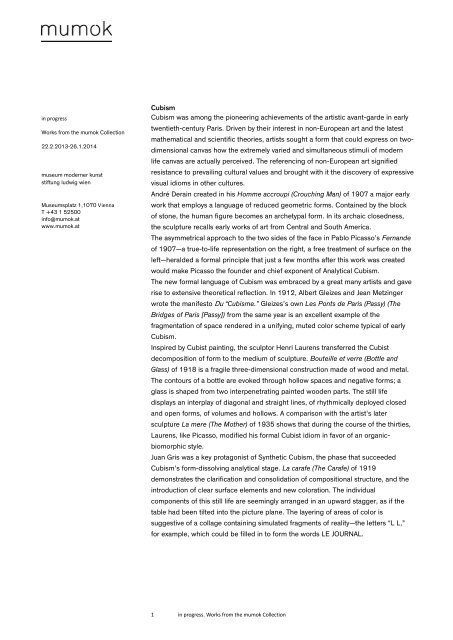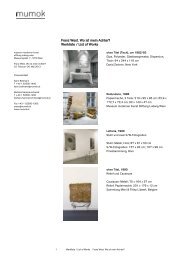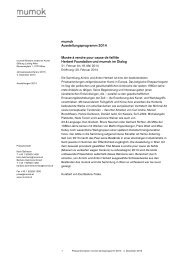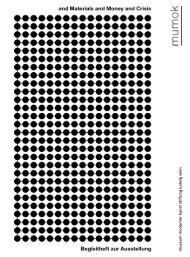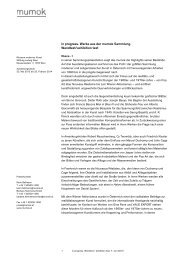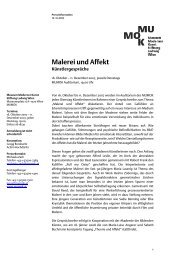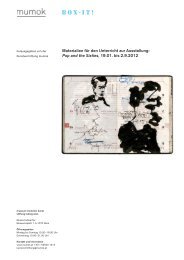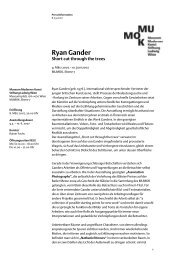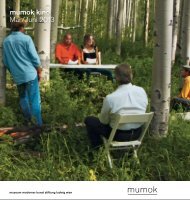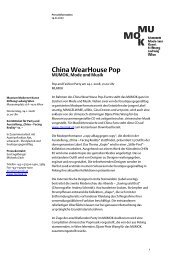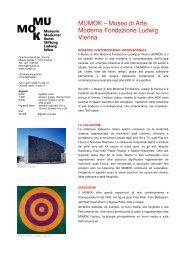Detailed information about the exhibition (212 KB) - Mumok
Detailed information about the exhibition (212 KB) - Mumok
Detailed information about the exhibition (212 KB) - Mumok
Create successful ePaper yourself
Turn your PDF publications into a flip-book with our unique Google optimized e-Paper software.
in progress<br />
Works from <strong>the</strong> mumok Collection<br />
22.2.2013-26.1.2014<br />
museum moderner kunst<br />
stiftung ludwig wien<br />
Museumsplatz 1,1070 Vienna<br />
T +43 1 52500<br />
info@mumok.at<br />
www.mumok.at<br />
Cubism<br />
Cubism was among <strong>the</strong> pioneering achievements of <strong>the</strong> artistic avant-garde in early<br />
twentieth-century Paris. Driven by <strong>the</strong>ir interest in non-European art and <strong>the</strong> latest<br />
ma<strong>the</strong>matical and scientific <strong>the</strong>ories, artists sought a form that could express on two-<br />
dimensional canvas how <strong>the</strong> extremely varied and simultaneous stimuli of modern<br />
life canvas are actually perceived. The referencing of non-European art signified<br />
resistance to prevailing cultural values and brought with it <strong>the</strong> discovery of expressive<br />
visual idioms in o<strong>the</strong>r cultures.<br />
André Derain created in his Homme accroupi (Crouching Man) of 1907 a major early<br />
work that employs a language of reduced geometric forms. Contained by <strong>the</strong> block<br />
of stone, <strong>the</strong> human figure becomes an archetypal form. In its archaic closedness,<br />
<strong>the</strong> sculpture recalls early works of art from Central and South America.<br />
The asymmetrical approach to <strong>the</strong> two sides of <strong>the</strong> face in Pablo Picasso’s Fernande<br />
of 1907—a true-to-life representation on <strong>the</strong> right, a free treatment of surface on <strong>the</strong><br />
left—heralded a formal principle that just a few months after this work was created<br />
would make Picasso <strong>the</strong> founder and chief exponent of Analytical Cubism.<br />
The new formal language of Cubism was embraced by a great many artists and gave<br />
rise to extensive <strong>the</strong>oretical reflection. In 1912, Albert Gleizes and Jean Metzinger<br />
wrote <strong>the</strong> manifesto Du “Cubisme.” Gleizes’s own Les Ponts de Paris (Passy) (The<br />
Bridges of Paris [Passy]) from <strong>the</strong> same year is an excellent example of <strong>the</strong><br />
fragmentation of space rendered in a unifying, muted color scheme typical of early<br />
Cubism.<br />
Inspired by Cubist painting, <strong>the</strong> sculptor Henri Laurens transferred <strong>the</strong> Cubist<br />
decomposition of form to <strong>the</strong> medium of sculpture. Bouteille et verre (Bottle and<br />
Glass) of 1918 is a fragile three-dimensional construction made of wood and metal.<br />
The contours of a bottle are evoked through hollow spaces and negative forms; a<br />
glass is shaped from two interpenetrating painted wooden parts. The still life<br />
displays an interplay of diagonal and straight lines, of rhythmically deployed closed<br />
and open forms, of volumes and hollows. A comparison with <strong>the</strong> artist’s later<br />
sculpture La mere (The Mo<strong>the</strong>r) of 1935 shows that during <strong>the</strong> course of <strong>the</strong> thirties,<br />
Laurens, like Picasso, modified his formal Cubist idiom in favor of an organic-<br />
biomorphic style.<br />
Juan Gris was a key protagonist of Syn<strong>the</strong>tic Cubism, <strong>the</strong> phase that succeeded<br />
Cubism’s form-dissolving analytical stage. La carafe (The Carafe) of 1919<br />
demonstrates <strong>the</strong> clarification and consolidation of compositional structure, and <strong>the</strong><br />
introduction of clear surface elements and new coloration. The individual<br />
components of this still life are seemingly arranged in an upward stagger, as if <strong>the</strong><br />
table had been tilted into <strong>the</strong> picture plane. The layering of areas of color is<br />
suggestive of a collage containing simulated fragments of reality—<strong>the</strong> letters “L L,”<br />
for example, which could be filled in to form <strong>the</strong> words LE JOURNAL.<br />
1 in progress. Works from <strong>the</strong> mumok Collection
Expressionism<br />
Not long after <strong>the</strong> turn of <strong>the</strong> twentieth century, <strong>the</strong> stylized, ornamental forms of<br />
Jugendstil gave way to a variety of expressive tendencies. While artists like Kolo<br />
Moser sought <strong>the</strong> symbolic elevation of <strong>the</strong> human figure—as seen, for example, in<br />
<strong>the</strong> pastel-colored, luminous beings of his painting Drei Frauen (Three Women) of ca.<br />
1914—<strong>the</strong> next generation of artists turned its attention to <strong>the</strong> radical expression of<br />
inner emotional states.<br />
Ernst Ludwig Kirchner was <strong>the</strong> dominant artistic personality of <strong>the</strong> Brücke, an artists’<br />
group founded in Dresden in 1905, whose members, including Karl Schmidt-Rottluff<br />
and Otto Mueller, introduced Expressionism to Germany. What united <strong>the</strong>se artists<br />
was <strong>the</strong>ir desire for au<strong>the</strong>ntic life experience beyond what <strong>the</strong>y saw as <strong>the</strong><br />
oppressive conventions of bourgeois society; <strong>the</strong>ir search for <strong>the</strong> unadulterated<br />
expression of emotion; and, finally, <strong>the</strong>ir longing for <strong>the</strong> unity of art and life.<br />
Kirchner’s Grünes Haus (Green House) of 1906 demonstrates how, even in a simple<br />
subject, <strong>the</strong> artist could translate <strong>the</strong> sensation of “reality’s stimulating effect” onto<br />
canvas using artistic means. Brushwork and color serve to express subjective<br />
perception: <strong>the</strong> artist’s spontaneous gesture covers <strong>the</strong> surface of <strong>the</strong> painting with<br />
vigorous, rhythmic brushstrokes; contrasts in red-green and blue-orange create a<br />
unity of figure and ground that merges all <strong>the</strong> elements of <strong>the</strong> painting in a visual<br />
whole—including <strong>the</strong> two people in <strong>the</strong> foreground.<br />
The Expressionist portraits of Viennese society produced in Austria around this time<br />
coincided with <strong>the</strong> early days of psychoanalysis and reflect <strong>the</strong> psyche of an era in<br />
transition. During his brief artistic career, Richard Gerstl developed a radical<br />
approach to painting, whose deliberate artlessness was directed against what he<br />
viewed as <strong>the</strong> inadequacy of historicist and Secessionist aes<strong>the</strong>tics. His portrait of<br />
<strong>the</strong> Familie Schönberg (The Schönberg Family) of 1907 shows <strong>the</strong> composer and his<br />
family as if lined up for a portrait photograph—though <strong>the</strong> usual claims to<br />
recognizability and narrative cohesion are lacking. Dispensing with a preliminary<br />
sketch, Gerstl applied <strong>the</strong> paint directly onto <strong>the</strong> canvas with a palette knife. Swirls of<br />
color consolidate into contourless forms, which <strong>the</strong>n dissolve and blend, leaving <strong>the</strong><br />
viewer with only <strong>the</strong> blurred shapes of <strong>the</strong> family members.<br />
Oskar Kokoschka’s portrait of Karl Kraus II of 1925—artist and subject were brought<br />
toge<strong>the</strong>r by <strong>the</strong> artist’s friend Adolf Loos—uses <strong>the</strong> medium of paint to expose <strong>the</strong><br />
writer’s personality. Kraus is shown exercising his intellectual powers, presenting his<br />
arguments with <strong>the</strong> aid of eccentric gestures. His face, accented in red and yellow,<br />
gives an impression of inner agitation. An inscription on <strong>the</strong> back of <strong>the</strong> painting<br />
reads: “Pro domo et mundo. The armchair on which Karl Kraus sat for this picture<br />
collapsed after <strong>the</strong> last sitting on 7 February 1925 and <strong>the</strong> carpenter had to be<br />
called. From <strong>the</strong> shipwrecked world of those who are born dull of comprehension,<br />
you have rescued a plank for a desk. OK”<br />
2 in progress. Works from <strong>the</strong> mumok Collection
Oskar Kokoschka, 1886 - 1980, exh. cat. Tate Gallery (London), Kunsthaus Zürich,<br />
Guggenheim, 1986, p. 311.<br />
Abstract arts<br />
The advent of Cubism in France spawned several different strands of strict geometric<br />
abstraction in early twentieth-century Europe. Prior to co-founding <strong>the</strong> De Stijl group<br />
in <strong>the</strong> Ne<strong>the</strong>rlands, Piet Mondrian had studied <strong>the</strong> works of Picasso and Braque in<br />
Paris. Starting from Cubism’s dissolution of form and dissection of pictorial space,<br />
Mondrian developed his principle of “pure abstraction” restricted to <strong>the</strong> primary<br />
colors red, blue, and yellow, to <strong>the</strong> noncolors black, white, and gray, and to vertical<br />
and horizontal lines. Using <strong>the</strong>se artistic elements, Mondrian sought to achieve a<br />
balance, a harmony between <strong>the</strong> parts, as a reflection of a universal harmony. The<br />
unfinished state of his Composition with Double Line and Blue of 1934 affords us an<br />
insight into Mondrian’s cautious and intuitive working method: <strong>the</strong> painting’s<br />
framework of black lines contains within it two lines sketched in charcoal as well as<br />
unpainted areas, suggesting a modification of <strong>the</strong> composition that was not actually<br />
carried out.<br />
The Hungarian-born László Moholy-Nagy developed his own distinctive geometric<br />
Constructivism, as seen in his Composition Q VIII of 1922. Here, transparent,<br />
geometric forms float in a state of suspension before a finely shaded gray<br />
background, <strong>the</strong>ir interpenetration generating spatial tension. Only <strong>the</strong> black<br />
elements provide <strong>the</strong> composition with a secure “hold” and structure. Moholy-Nagy’s<br />
pictorial concept is derived from experiments with light and transparent materials in<br />
<strong>the</strong> mediums of architecture and sculpture. In 1923, Walter Gropius invited Moholy-<br />
Nagy to teach at <strong>the</strong> Bauhaus in Weimar, where he would have a formative influence<br />
on <strong>the</strong> school’s technical and Constructivist orientation.<br />
In Germany, Walter Dexel was one of a number of artists who tried to anchor <strong>the</strong><br />
principles of strict geometric abstraction in <strong>the</strong> worlds of advertising and everyday<br />
culture. As a painter, commercial artist, and designer he wanted his idea of <strong>the</strong><br />
“syntax inherent in <strong>the</strong> image” to be used in all practical areas of everyday urban life.<br />
Architecture, interior design, and applied arts as “exemplary industrial and<br />
handcrafted products” were of paramount interest to him; he viewed painting<br />
<strong>exhibition</strong>s as only “part of a whole.”<br />
It was precisely <strong>the</strong>se forms of abstract art—beholden to a constructional, geometric,<br />
compositional structure and put to use in commercial art and everyday design—that<br />
Robert Delaunay disapproved of. With “pure painting” as his objective, he sought a<br />
radical break with <strong>the</strong> traditional constructional aspect of painting, even at <strong>the</strong> cost of<br />
its destruction. Delaunay’s supremely experimental Relief Blanc of 1936 takes his<br />
notion of “pure color painting”—in which color is both form and content—a stage<br />
fur<strong>the</strong>r by eliminating color in favor of <strong>the</strong> painting of light.<br />
3 in progress. Works from <strong>the</strong> mumok Collection
Bauhaus<br />
Founded by Walter Gropius in Weimar in 1919, <strong>the</strong> Bauhaus art school sought an<br />
interaction of all <strong>the</strong> arts that would bring <strong>about</strong> a syn<strong>the</strong>sis of art, craft, and<br />
industrial mass production and in doing so secure art’s place in modern life.<br />
Teachers at <strong>the</strong> school, including Wassily Kandinsky, Lyonel Feininger, Paul Klee,<br />
Oskar Schlemmer, Ludwig Mies van der Rohe, and Herbert Bayer, united around <strong>the</strong><br />
principles of objectivity, functionality, and social responsibility. After moving to<br />
Dessau in 1925, and <strong>the</strong>n to Berlin in 1932, <strong>the</strong> Bauhaus was closed by <strong>the</strong> Nazis in<br />
1933.<br />
Wassily Kandinsky joined <strong>the</strong> Bauhaus faculty in 1922 as master for mural painting<br />
and <strong>the</strong> <strong>the</strong>ory of form. Trotzig (Obstinate) of 1933 reveals his reservations vis-à-vis<br />
<strong>the</strong> absolutism of <strong>the</strong> purely Constructivist pictorial principles propagated by <strong>the</strong><br />
Bauhaus. Kandinsky saw abstraction as <strong>the</strong> expression of a spiritual order, where<br />
colors and forms are coordinated in consonant or dissonant relationships, <strong>the</strong> way<br />
sounds are in music. In Trotzig, finely nuanced geometric planes float in rhythmic<br />
balance on a red ground. Only in <strong>the</strong> work’s title is <strong>the</strong>re any suggestion of a<br />
concrete reference: an “obstinate” animal seems to be turning its head away from a<br />
red celestial body. Following <strong>the</strong> example of Paul Klee, Kandinsky translated his<br />
abstract forms into something intuitive and poetic, thus giving an ironic spin to <strong>the</strong><br />
Bauhaus’s rational-abstract approach.<br />
Klee himself painted his Boote und Klippen (Boats and Cliffs) in 1927 while a teacher<br />
at <strong>the</strong> Dessau Bauhaus. The painting displays <strong>the</strong> characteristics typical of strict<br />
Constructivism, albeit softened by Klee’s sense of humor and feeling for poetry.<br />
Here, geometric surfaces defined by intersecting lines and filled out in brilliant colors<br />
are assembled along <strong>the</strong> line where two horizontal bands of color make contact. The<br />
seeming playfulness of <strong>the</strong> composition is suggestive of an unconscious act of<br />
creation born of an inner impulse—an act of creation that Klee saw as analogous to<br />
<strong>the</strong> creation of <strong>the</strong> world. The title is a poetic commentary and forges a link between<br />
autonomous, purely artistic means and figurative association.<br />
Oskar Schlemmer taught at <strong>the</strong> Bauhaus from 1920 to 1928, first as head of <strong>the</strong><br />
mural-painting workshop and later for <strong>the</strong> stone-sculpture and stage workshops. As<br />
varied as Schlemmer’s activities were, <strong>the</strong> focus of his attention remained <strong>the</strong> human<br />
figure and its relation to space. He strove for an ideal, modern, and timeless human<br />
type. Abstrakte Figur (Abstract Figure) of 1921 is Schlemmer’s only figurative<br />
sculpture. Reduced to basic geometric forms in an elegant interplay of shell and<br />
core, <strong>the</strong> figure resembles an idol, a symbol of modern man in an age defined by<br />
technology and rationality. The execution in nickel-plated bronze results in a shiny,<br />
light-reflecting surface that releases <strong>the</strong> figure from its materiality, delivering it into a<br />
timeless realm.<br />
4 in progress. Works from <strong>the</strong> mumok Collection
Surrealism<br />
Originating in Paris in <strong>the</strong> early twenties, Surrealism was a movement that attempted<br />
to probe and portray <strong>the</strong> unreal, dreamlike character of social reality, and to plumb<br />
<strong>the</strong> depths of <strong>the</strong> unconscious. In his Surrealist Manifesto of 1924, André Breton<br />
pleaded for <strong>the</strong> contradictory states of unreality and reality to be reconciled in an<br />
absolute “surreality,” where <strong>the</strong> usual ways of thinking and perceiving would no<br />
longer be valid. His acquaintance with Breton and <strong>the</strong> Parisian Surrealists influenced<br />
<strong>the</strong> artist André Masson in his development of an art removed from rational<br />
considerations—an art that with <strong>the</strong> aid of écriture automatique (automatic writing)<br />
could access <strong>the</strong> irrational and <strong>the</strong> depths of <strong>the</strong> unconscious. Masson devised a<br />
method of pictorial invention that incorporated glue and sand; works were <strong>the</strong>n<br />
finished with an act of spontaneous painting and assigned associative titles—as in<br />
Oiseaux (Birds) of 1927.<br />
Max Ernst’s Étes-vous Niniche? (Are You Niniche?) of 1955–56 is a combination of<br />
commonplace found elements—a fact that is often noticed only upon closer<br />
inspection of <strong>the</strong> work. The artist mounted two ox yokes to create a sculpture whose<br />
rigidly frontal composition recalls an archaic cult statue. The name “Niniche” appears<br />
on <strong>the</strong> printing plate that functions as a base. The title is deliberately misleading: a<br />
question addressed directly to <strong>the</strong> viewer, it encourages <strong>the</strong> interpretation of<br />
individual elements which in fact have no connection. Masks, mythical figures, and<br />
cult statues were all part of Ernst’s mysterious, cryptic visual world, and he became<br />
increasingly preoccupied with such things after World War II.<br />
René Magritte worked with distinctly familiar objects, to which he lent a paradoxical,<br />
distorting twist that proves disconcerting only upon second glance. La voix du sang<br />
(The Voice of Blood) of 1959 features an immense tree in a vast nocturnal<br />
landscape. The tree’s trunk is opened up like a cupboard, revealing a house and a<br />
sphere that confuse <strong>the</strong> viewer’s sense of scale. In his work, Magritte undermines<br />
our false familiarity with everyday things. The unity of image and concept dissolves,<br />
and <strong>the</strong> meanings of things begin to shift: “A distinction must always be made<br />
between what a thing signifies and <strong>the</strong> idea one has of thing.”<br />
Johannes Itten<br />
Swiss painter Johannes Itten moved to Vienna in 1916 to open a private art school.<br />
There, among <strong>the</strong> artists who frequented Alma Mahler’s famous salon, he made <strong>the</strong><br />
acquaintance of Walter Gropius and in <strong>the</strong> summer of 1919 was invited by Gropius<br />
to teach at <strong>the</strong> newly founded Bauhaus in Weimar. The experience that Itten had<br />
ga<strong>the</strong>red at his art school in Vienna provided an important basis for <strong>the</strong> development<br />
of <strong>the</strong> preliminary course at <strong>the</strong> Bauhaus.<br />
But Itten’s works also had a seminal impact in Vienna. At an <strong>exhibition</strong> of his<br />
paintings organized by Adolf Loos in May 1919, Itten met <strong>the</strong> Austrian composer<br />
5 in progress. Works from <strong>the</strong> mumok Collection
Josef Matthias Hauer, an encounter that would be of great consequence. In Itten’s<br />
structured compositions and in <strong>the</strong> totality of colors that he was trying to achieve,<br />
Hauer saw parallels with his own search for a new comprehensive principle of<br />
musical order. Painter and composer <strong>the</strong>reupon entered into an intensive exchange<br />
of ideas lasting several months in <strong>the</strong> course of which <strong>the</strong>y explored <strong>the</strong> various ways<br />
in which musical and artistic principles are connected. Both were keenly interested<br />
in <strong>the</strong> correspondence between <strong>the</strong> twelve-part color circle and <strong>the</strong> twelve-tone<br />
circle.<br />
Itten’s paintings prompted Hauer to begin composing again after several years of<br />
creative crisis. He dedicated his first compositions to Johannes Itten and his wife<br />
Hildegard. A pioneering breakthrough of musico-historical significance occurred just<br />
a few months later in August 1919, when Hauer completed his Op. 19, <strong>the</strong> first<br />
twelve-tone composition in <strong>the</strong> history of European music. The meeting of <strong>the</strong>se two<br />
artists was thus one of modernism’s defining moments.<br />
Soon afterwards, Hauer sent Itten his “Sonnenmelos,” a poem he had written and set<br />
to music based on Op. 19. While Itten was in Weimar performing Hauer’s twelve-<br />
tone compositions and dabbling in composing under his guidance, Hauer was in<br />
Vienna experimenting with <strong>the</strong> conversion of tone rows into compositions of color<br />
and form in front of one of Itten’s paintings.<br />
Itten’s work was not without influence on <strong>the</strong> young art scene in early nineteen-<br />
twenties Vienna. It inspired not only those artists who went with him to Weimar, but<br />
also <strong>the</strong> works of Erika Giovanna Klien and Otto Erich Wagner, who were among <strong>the</strong><br />
leading protagonists of Viennese Kinetism. They were part of an artistic awakening<br />
that was taking place on several different fronts at once and whose productive<br />
engagement with European modernism came to an end with <strong>the</strong> economic decline<br />
and political radicalization of <strong>the</strong> thirties.<br />
Marcel Duchamp<br />
Marcel Duchamp’s Boîte-en-valise (Box in a Valise) is a portable miniature museum<br />
containing sixty-nine finely made reproductions of works by <strong>the</strong> artist. Between 1935<br />
and 1941 Duchamp created a luxury edition of twenty boxes nesting inside a brown<br />
lea<strong>the</strong>r valise, <strong>the</strong> design and content of which varied slightly from piece to piece. A<br />
later edition of six different series was compiled in <strong>the</strong> nineteen-fifties and sixties.<br />
Here, Duchamp dispensed with <strong>the</strong> valise but covered <strong>the</strong> boxes of each series in a<br />
different color of fabric.<br />
The contents in most cases are not attached to <strong>the</strong> boxes <strong>the</strong>mselves and so can be<br />
taken out at will. Since <strong>the</strong> remainder are fixed, Duchamp’s choice of juxtapositions<br />
allows us to establish certain links and draw certain conclusions <strong>about</strong> <strong>the</strong> artist’s<br />
highly complex conceptual world. At <strong>the</strong> center of <strong>the</strong> opened box is a reproduction<br />
6 in progress. Works from <strong>the</strong> mumok Collection
of La Mariée mise à nu par ses célibataires, meme, also known as Le grand verre (The<br />
Large Glass).<br />
The <strong>the</strong>me of <strong>the</strong> artist’s opus magnum, which was begun in 1915 and declared<br />
finished, although unfinished, in 1923, is a union that never actually takes place but<br />
is ra<strong>the</strong>r only projected, as it were. Whereas <strong>the</strong> title translates as The Bride Stripped<br />
Bare by her Bachelors, Even, <strong>the</strong> “Bride’s Domain” at <strong>the</strong> top and “Bachelors’<br />
Domain” at <strong>the</strong> bottom are in fact kept strictly separate, making any attempt to strip<br />
anyone bare all but impossible. The men can approach <strong>the</strong> woman only with <strong>the</strong> aid<br />
of a complicated piece of machinery, and even <strong>the</strong>n only virtually. The Large Glass<br />
consists of many parts and functions on many levels that up to a point make sense to<br />
those familiar with <strong>the</strong> artist’s o<strong>the</strong>r works. The power source that sets <strong>the</strong> millwheel<br />
and with it <strong>the</strong> whole contraption in motion is not apparent. La Boîte verte (The Green<br />
Box) is a collection of loose-leaf notes and sketches that Duchamp began amassing<br />
around 1912 and published as a kind of instruction manual for his Large Glass in<br />
1934. One of <strong>the</strong> notes included <strong>the</strong>re contains a key pointer: “Waterfall. A kind of<br />
fountain, which from far away falls down in a semicircle over <strong>the</strong> male casts.” Below<br />
this is a little drawing that shows how <strong>the</strong> waterfall connects with <strong>the</strong> “watermill” of<br />
<strong>the</strong> runner.<br />
It is certainly not by chance that to <strong>the</strong> left of The Large Glass <strong>the</strong>re is an<br />
arrangement of miniaturized replicas of three readymades: Air de Paris of 1919, a<br />
glass phial filled with Parisian air at <strong>the</strong> level of <strong>the</strong> Bride’s Domain; Fontaine of<br />
1917, <strong>the</strong> famous urinal, positioned near <strong>the</strong> Bachelors’ Domain; and between <strong>the</strong>m<br />
<strong>the</strong> (Pliant de voyage) (Traveller’s Folding Item) of 1916. The latter item is in fact a<br />
cover for an Underwood typewriter. Duchamp is said to have compared this cover<br />
with a woman’s dress and it was to be mounted on a stand at such a height that <strong>the</strong><br />
viewer would want to duck down in order to see what is hidden underneath.<br />
7 in progress. Works from <strong>the</strong> mumok Collection


